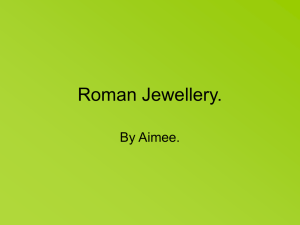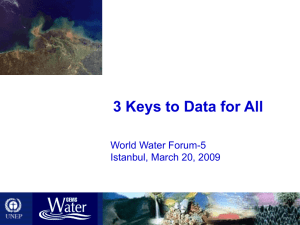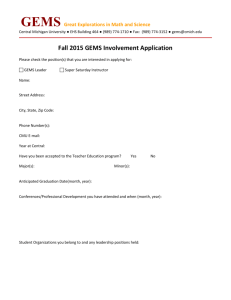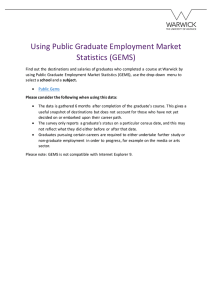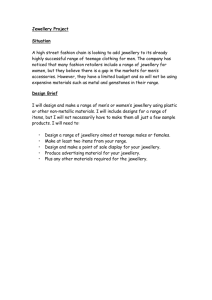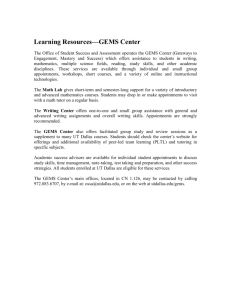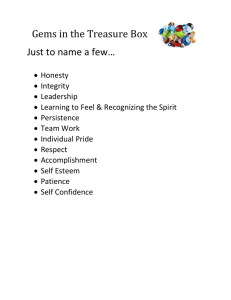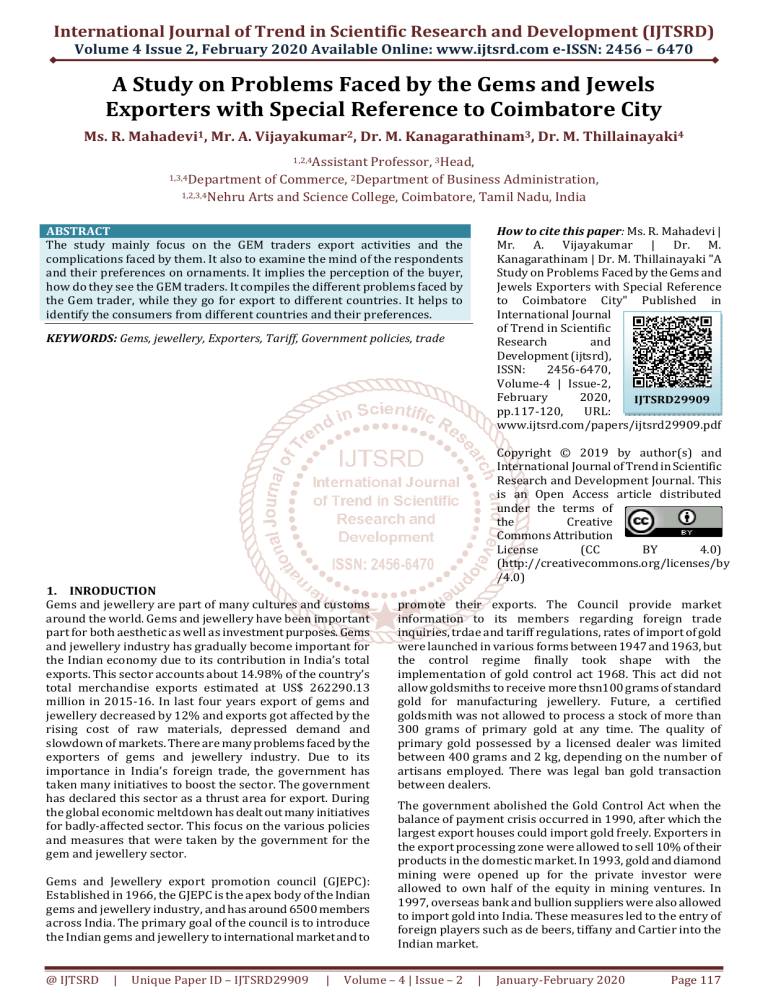
International Journal of Trend in Scientific Research and Development (IJTSRD)
Volume 4 Issue 2, February 2020 Available Online: www.ijtsrd.com e-ISSN: 2456 – 6470
A Study on Problems Faced by the Gems and Jewels
Exporters with Special Reference to Coimbatore City
Ms. R. Mahadevi1, Mr. A. Vijayakumar2, Dr. M. Kanagarathinam3, Dr. M. Thillainayaki4
1,2,4Assistant
Professor, 3Head,
1,3,4Department of Commerce, 2Department of Business Administration,
1,2,3,4Nehru Arts and Science College, Coimbatore, Tamil Nadu, India
How to cite this paper: Ms. R. Mahadevi |
Mr. A. Vijayakumar | Dr. M.
Kanagarathinam | Dr. M. Thillainayaki "A
Study on Problems Faced by the Gems and
Jewels Exporters with Special Reference
to Coimbatore City" Published in
International Journal
of Trend in Scientific
Research
and
Development (ijtsrd),
ISSN:
2456-6470,
Volume-4 | Issue-2,
February
2020,
IJTSRD29909
pp.117-120,
URL:
www.ijtsrd.com/papers/ijtsrd29909.pdf
ABSTRACT
The study mainly focus on the GEM traders export activities and the
complications faced by them. It also to examine the mind of the respondents
and their preferences on ornaments. It implies the perception of the buyer,
how do they see the GEM traders. It compiles the different problems faced by
the Gem trader, while they go for export to different countries. It helps to
identify the consumers from different countries and their preferences.
KEYWORDS: Gems, jewellery, Exporters, Tariff, Government policies, trade
Copyright © 2019 by author(s) and
International Journal of Trend in Scientific
Research and Development Journal. This
is an Open Access article distributed
under the terms of
the
Creative
Commons Attribution
License
(CC
BY
4.0)
(http://creativecommons.org/licenses/by
/4.0)
1. INRODUCTION
Gems and jewellery are part of many cultures and customs
around the world. Gems and jewellery have been important
part for both aesthetic as well as investment purposes. Gems
and jewellery industry has gradually become important for
the Indian economy due to its contribution in India’s total
exports. This sector accounts about 14.98% of the country’s
total merchandise exports estimated at US$ 262290.13
million in 2015-16. In last four years export of gems and
jewellery decreased by 12% and exports got affected by the
rising cost of raw materials, depressed demand and
slowdown of markets. There are many problems faced by the
exporters of gems and jewellery industry. Due to its
importance in India’s foreign trade, the government has
taken many initiatives to boost the sector. The government
has declared this sector as a thrust area for export. During
the global economic meltdown has dealt out many initiatives
for badly-affected sector. This focus on the various policies
and measures that were taken by the government for the
gem and jewellery sector.
Gems and Jewellery export promotion council (GJEPC):
Established in 1966, the GJEPC is the apex body of the Indian
gems and jewellery industry, and has around 6500 members
across India. The primary goal of the council is to introduce
the Indian gems and jewellery to international market and to
@ IJTSRD
|
Unique Paper ID – IJTSRD29909
|
promote their exports. The Council provide market
information to its members regarding foreign trade
inquiries, trdae and tariff regulations, rates of import of gold
were launched in various forms between 1947 and 1963, but
the control regime finally took shape with the
implementation of gold control act 1968. This act did not
allow goldsmiths to receive more thsn100 grams of standard
gold for manufacturing jewellery. Future, a certified
goldsmith was not allowed to process a stock of more than
300 grams of primary gold at any time. The quality of
primary gold possessed by a licensed dealer was limited
between 400 grams and 2 kg, depending on the number of
artisans employed. There was legal ban gold transaction
between dealers.
The government abolished the Gold Control Act when the
balance of payment crisis occurred in 1990, after which the
largest export houses could import gold freely. Exporters in
the export processing zone were allowed to sell 10% of their
products in the domestic market. In 1993, gold and diamond
mining were opened up for the private investor were
allowed to own half of the equity in mining ventures. In
1997, overseas bank and bullion suppliers were also allowed
to import gold into India. These measures led to the entry of
foreign players such as de beers, tiffany and Cartier into the
Indian market.
Volume – 4 | Issue – 2
|
January-February 2020
Page 117
International Journal of Trend in Scientific Research and Development (IJTSRD) @ www.ijtsrd.com eISSN: 2456-6470
1.1.
GEOGRAPHIC SPREAD OF GEMS AND JEWELLERY
INDUSTRY
Jewellery making is spread throughout the country with
every village having a family of goldsmiths. The diamond
processing industry has spread 5 from the State of Gujarat,
which accounts for almost 85 per cent of the diamonds
processed in India, to other states. Surat, Bhavnagar and
Ahemedabad are the diamond centres in Gujarat. Many
diamond processing units have been set up in Mumbai in
Maharashtra. There are also diamond processing units in
Trichur in Kerala, Coimbatore in Tamil Nadu, Jaipur in
Rajasthan and also in Goa. Mumbai continues to be the main
trading centre for diamond exports. Almost 93 per cent of
diamond exports are dispatched through Mumbai airport.
The jewellery crafting and designing is confined to only a few
regions in the country and every region specializes in
separate craftsmanship skills. The main clusters in Indian
gems and jewellery industry are following.
1.2. STATEMENT OF THE PROBLEM
Rising competition from other countries.
They need to import more raw materials from other
country.
There is no proper fixed rate for the gold and
jewells,each and every day there will be a change in
price schedule.
Manufacturers has to pay more duty for import of raw
materials.
1.3. OBJECTIVE OF THE STUDY
The objective are
To know the consequences gems and jewellery industry.
To study about the competitive position of gems and
industry export.
To analysis the vital step for improving the gems and
jewellery export.
1.4. RESEARCH METHODOLOGY
The study is basically an analytical study based on the
primary research, this kind of research has the primary
objective of development of insight into the problem. The
research methodology for the study has been adopted to
reflect these realties and help reach the logical in an
objective manner. In order to conduct this study,
questionnaire has been used for collecting the data.
data so collected from both primary and secondary sources
have been presented in this research report to the
appropriate places.
1.4.3. DATA COLLECTION
The data was collected from the gems and jewellery
exporters, who are exporting their products from to other
countries. Most of the data was collected from the merchant
exporters and manufacturer exporters.
sample size
Sample size of 70 respondents are only taken for collecting
the data, what are the problem faced by the gems and
jewellery exporters.
Sampling area
The data was collected only in and around Coimbatore city.
Sampling unit
GEMS AND JEWELLERY Traders and Manufactures operating
in Coimbatore, particular the owner, managers and other
official persons.
1.5. LIMITATION OF THE STUDY
The sample group was collected in and around
Coimbatore city.
The sample size for the survey has very low of 70
respondent.
Beside the study has the limitation of time,place and
resources.
1.6. TOOLS USED FOR THE STUDY
The collected data were classified, tabulated and analysed
with some of the statistical tools listed below:
Simple Percentage Analysis.
SIMPLE PERCENTAGE ANALYSIS
Simple percentage analysis is used in making
comparison between two or more series of data. A
percentage is used to determine relationship between the
series. It is the method to represent raw streams of data as a
percentage (a part in 100 - percent) for better understanding
of collected data .Percentage Analysis is applied to create a
contingency table from the frequency distribution and
represent the collected data for better understanding.
No of respondents
1.4.1. TYPE OF RESEARCH
This is a descriptive research where survey method is
adopted to collect primary data from the gems and jewellery
exporters and manufactures and the required secondary
information for analyses.
Simple percentage =
*100
Total no of respondents
1.4.2. SOURCE OF DATA
PRIMARY DATA
The primary data are those which are collected for the first
time and thus happened to be original in character. Primary
data will be collected through a questionnaire raised among
the gems and jewellery traders and manufactures in and
around in Coimbatore.
1. EXPERIENCE IN THE JEWELLERY FIELD
Table shows the experience in Jewellery field
S.N
NO.OF.
EXPERIENCE
%
O
RESPONDENT
1
0 TO 5
11
16
2
5 TO 10
35
8
3
10 TO 15
18
26
4
More than 15 years
6
50
TOTAL
70
100
Source: Primary data
SECONDARY DATA
Secondary data that is already available and published, it
could be internal and external of data. The secondary data is
being collected through text boos, journals, library etc. The
INTERPRETATION
The above table shows the year of experience in the
jewellery field, out of 100 percentage, 50 percentage of the
respondent are more than 15 years experience,
@ IJTSRD
|
Unique Paper ID – IJTSRD29909
|
Volume – 4 | Issue – 2
|
January-February 2020
Page 118
International Journal of Trend in Scientific Research and Development (IJTSRD) @ www.ijtsrd.com eISSN: 2456-6470
26percentageof the respondent are 10 to 15 year experience,
16percentage of the respondent are 0 to 5 year experience,
8percentage of the respondent are 5 to 10 years of
experience in this field.
2. NATURE OF OWNERSHIP
Table Shows the nature of ownership
NATURE OF
NO.OF.
S. NO
%
OWNERSHIP
RESPONDENT
1
Partnership
24
34
2
Private limited
46
66
3
others
TOTAL
70
100
Source: Primary data
INTERPRETATION
It clearly explain about the nature of ownership, 66
percentage runs the private limited and only 34 percentage
run the partnership .
3. TYPE OF EXPORTER
Table shows the type of exporters
TYPE OF
NO. OF.
S.NO
%
EXPOTER
RESPONDENT
Merchant
1
24
66
exporter
Manufacturing
2
46
34
exporter
TOTAL
70
100
Source: Primary data
4. CURRENCY FREQUENTLYUSED
Table Shows the currency frequently used
S.
CURRENCY
NO.OF.
%
NO FREQUENTLY USED RESPONDENT
1
Dollar
32
46
2
Euro
27
39
3
Yen
5
7
4
others
6
8
TOTAL
70
100
Source: Primary data
INTREPRETATION
The above table clearly shows the currency frequently used
by the exporter, out of 100 percentage, 46percentage of
respondents are using dollar, 39percentage of respondents
are using euro currency, 8percentage of the respondent are
using other currencies for exchange and only 7percentage of
the respondent are using yen.
5. EXPORTING TO HOW MANY COUNTRIES
Table shows the exporting to how many countries
S.
NO.OF.
NO. OF.
%
NO
COUNTRIES
RESPONDENT
1
1
15
21
2
2
35
50
3
3
11
16
4
More than 4
9
13
TOTAL
70
100
Source: Primary data
|
Unique Paper ID – IJTSRD29909
|
6. TYPES OF PRODUCTS DEALING
Table shows the products dealing
S.
NO. OF.
PRODUCTS
NO
RESPONDENT
1
Gold
27
2
Gems stones
19
Platinum or
3
20
diamond
4
Silver
4
TOTAL
70
Source: Primary data
%
39
27
28
6
100
INTERPRETATION
The above table clearly explain about the products that
dealing for export gems and jewellery, out of 100 percentage,
39percentage of the respondent are exporting gold,
28percentage of the respondent are exporting platinum and
diamond, 27percentage of the respondent are exporting
gems and stones and only less than 6percentage of the
respondent are exporting silver.
INTREPRETATION
The above table clearly explains about the type of exporter
,out of 100percentage of respondent, 66percentage of
respondent are merchant exporter, and remaining
34percentagerespondent are manufacturing exporter.
@ IJTSRD
INTERPRETATION
The above table clearly explain about the gems and jewellery
exporting to many countries, out of 100 percentage,
50percentage of the respondent are exporting to 2 countries,
21percentage of the respondent are exporting to 1 countries,
16percentage of the respondent are exporting to 3countries,
and only 13percentage of the respondent are exporting more
than 4 countries.
5. FINDINGS AND SUGGESTIONS
5.1. FINDINGS
Majority of the respondents are from more than 50
years of experience in their company with 50%.
It is clear that majority with 66% of the respondents are
running private limited.
It is clear that majority with 66% of the respondents are
merchant exporter.
The study revels that 46% of the respondents are
frequently used dollar for exporting of gems and gold.
50% of the respondents are exporting the gems and
jewelry
The study revels that 39% of the respondents are told
that the exporters are mostly prefer to export gold
items.
CONCLUSION
From the above study, I conclude that majority of the
respondents are facing many problems with day to day
activities and also they are satisfied with the business
performance. These types of issues rise because of inflation
in the price level and insufficient of raw material and less
support from the government, gems and jewellery export
promotion council and other financial institutions. Their
major drawback is low productivity of gold ornaments and
they cannot able to face heavy competition in the domestic
and in international market. Most of the exporters are
expecting there will be some changes to boost up the gems
and jewellery export business in India. Government and
Gems and Jewellery Export in India.
Volume – 4 | Issue – 2
|
January-February 2020
Page 119
International Journal of Trend in Scientific Research and Development (IJTSRD) @ www.ijtsrd.com eISSN: 2456-6470
References
[1] Shukla, M. S. (2000), “Panorama of Gems and Jewellery
in Indian Historical Setting”, Kala Prakashan, Varanasi.
[3] Satya Sundaram, I. (2001), “Gems and Jewellery
Industry-Vast Export Potential”, Published in Facts for
You, September, pp. 13-14.
[2] Purani, Keyoor (2000), “Gujarat Model of
Entrepreneurial Innovation: A Study of Surat Diamond
Industry”, Working Paper No. wp/eu- ind/120, Seak
Centre, University of Brighton, UK, Online at
www.it.brighton.ac.uk/research/euindia.
[4] Satya Sundaram. I. (2001), “Gems and Jewellery
Industry-Vast Export Potential”, Published in Facts for
You,pp 13-14.
@ IJTSRD
|
Unique Paper ID – IJTSRD29909
|
[5] Ramamrutham, Usha B. K., Meera Sushil Kumar (2001)
“Indian Jewellery: Dance of the peacock” India Book
House, New Delhi.
Volume – 4 | Issue – 2
|
January-February 2020
Page 120

